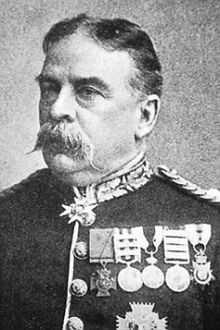Hugh Henry Gough
| Hugh Henry Gough | |
|---|---|
 | |
| Born |
14 November 1833 Calcutta, British India |
| Died |
12 May 1909 (aged 75) St Thomas Tower, Tower of London |
| Buried at | Kensal Green Cemetery |
| Allegiance |
|
| Service/branch |
Bengal Army British Army British Indian Army |
| Rank | General |
| Battles/wars |
Second Anglo-Afghan War Indian Mutiny Abyssinian War |
| Awards |
Victoria Cross Order of the Bath |
| Relations |
General Sir Charles J.S. Gough, VC (brother) Charlotte Elise Gough, Lady Wilson (daughter) Field Marshal The 1st Viscount Gough (grandfather) General Sir Hubert Gough (nephew) Brigadier General Sir John Edmund Gough, VC (nephew) Field Marshal The 1st Viscount Gough (great-uncle) |
| Other work | Keeper of the Jewel House |
General Sir Hugh Henry Gough, VC, GCB (/ˈɡɒf/; 14 November 1833 – 12 May 1909), was born into an Anglo-Irish aristocratic family in Calcutta, Bengal, India, and was a recipient of the Victoria Cross, the highest and most prestigious award for gallantry in the face of the enemy that can be awarded to British and Commonwealth forces.
Details
Gough was 23 years old, and a lieutenant in the 1st Bengal European Light Cavalry (later 19th Hussars) during the Indian Mutiny, when the following deeds took place for which he was awarded the VC:
1st Bengal European Light Cavalry, Lieutenant Hugh Henry GoughDate of Acts of Bravery, 12th November, 1857, and 25th February, 1858
Lieutenant Gough, when in command of a party of Hodson's Horse, near Alumbagh, on the 12th of November, 1857, particularly distinguished himself by his forward bearing in charging across a swamp, and capturing two guns, although defended by a vastly superior body of the enemy. On this occasion he had his horse wounded in two places, and his turban cut through by sword cuts, whilst engaged in combat with three Sepoys.
Lieutenant Gough also particularly distinguished himself, near Jellalabad, Lucknow, on 25 February 1858, by showing a brilliant example to his Regiment, when ordered to charge the enemy's guns, and by his gallant and forward conduct, he enabled them to effect their object. On this occasion he engaged himself in a series of single combats, until at length he was disabled by a musketball through the leg, while charging two Sepoys with fixed bayonets. Lieutenant Gough on this day had two horses killed under him, a shot through his helmet, and another through his scabbard, besides being severely wounded.[1]
Later career
Gough achieved the rank of General. He was appointed Keeper of the Jewel House at the Tower of London and Lieutenant-Governor of the Channel Islands.
Family
General Gough was the son of Judge George Gough and Charlotte Margaret Becher. He was brother to General Sir Charles J.S. Gough, VC, and uncle of the World War I commanders General Sir Hubert Gough and Brigadier General Sir John Edmund Gough, VC. He was the grandson of Field Marshal The 1st Viscount Gough.[2] His daughter, Charlotte Elise Gough (died 17 August 1942), married the World War I commander Lt-General Sir Henry Fuller Maitland Wilson, by whom she had three children:[3]
- Arthur Henry Maitland Wilson, b 22 January 1885, accidentally killed 29 January 1918.
- Hugh Maitland Wilson, 6 April 1886.
- Muriel Maitland Wilson, died unmarried 25 June 1950.
Works
- Old Memories. Cornell University Library (1 January 1897) ISBN 978-1-4297-4127-9
Notes
- ↑ The London Gazette: no. 22212. p. 5516. 24 December 1858. Retrieved 19 September 2009.
- ↑ Goughie: the Life of General Sir Hubert Gough (Anthony Farrar-Hockley, 1975)
- ↑ Burke's Peerage, Baronetage and Knightage ('Wilson')
References
- Irish Winners of the Victoria Cross (Richard Doherty & David Truesdale, 2000)
- Monuments to Courage (David Harvey, 1999)
- The Register of the Victoria Cross (This England, 1997)
External links
- Location of grave and VC medal (Kensal Green Cemetery)
- Biography
|